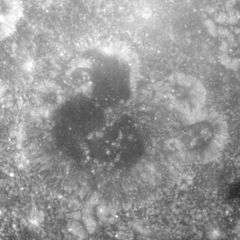Apollonius (crater)
 Apollo 15 image | |
| Coordinates | 4°30′N 61°06′E / 4.5°N 61.1°ECoordinates: 4°30′N 61°06′E / 4.5°N 61.1°E |
|---|---|
| Diameter | 53 km |
| Depth | 1.5 km |
| Colongitude | 299° at sunrise |
| Eponym | Apollónius |



Apollonius is a lunar impact crater named after Apollonius of Perga located near the eastern limb of the Moon. It lies in the region of uplands to the west of Mare Undarum and northeast of the Sinus Successus on the Mare Fecunditatis. At this location, on Earth, the crater appears oval due to foreshortening, but the crater is nearly circular. It is southwest of the crater Firmicus, and north of Condon.
The outer rim of Apollonius is somewhat worn and is overlain by a pair of small craters (including Apollonius E) across the western wall. The nearly flat interior floor has a low albedo and has been covered by lava. It lacks a central peak or notable small craters across the bottom.
From that location the Earth would appear in the lunar sky at less than 29 degrees from the top towards the west and 4 degrees to the left.
Satellite craters
By convention these features are identified on lunar maps by placing the letter on the side of the crater midpoint that is closest to Apollonius.
| Apollonius | Latitude | Longitude | Diameter |
|---|---|---|---|
| A | 4.8° N | 56.8° E | 24 km |
| B | 5.7° N | 57.6° E | 32 km |
| E | 4.4° N | 61.9° E | 16 km |
| F | 5.6° N | 60.0° E | 16 km |
| H | 3.4° N | 59.6° E | 20 km |
| J | 4.6° N | 57.5° E | 12 km |
| L | 6.5° N | 54.6° E | 9 km |
| M | 4.8° N | 61.9° E | 10 km |
| N | 4.8° N | 64.1° E | 9 km |
| S | 1.1° N | 62.6° E | 15 km |
| U | 4.9° N | 59.9° E | 7 km |
| V | 4.4° N | 58.2° E | 16 km |
| X | 7.0° N | 58.1° E | 31 km |
| Y | 4.9° N | 62.6° E | 10 km |
The following craters have been renamed by the IAU.
- Apollonius C — See Ameghino (crater).
- Apollonius D — See Cartan (crater).
- Apollonius G — See Townley (crater).
- Apollonius K — See Abbot (crater).
- Apollonius P — See Daly (lunar crater).
- Apollonius T — See Bombelli (crater).
- Apollonius W — See Petit (crater).
References
- Andersson, L. E.; Whitaker, E. A. (1982). NASA Catalogue of Lunar Nomenclature. NASA RP-1097.
- Blue, Jennifer (July 25, 2007). "Gazetteer of Planetary Nomenclature". USGS. Retrieved 2007-08-05.
- Bussey, B.; Spudis, P. (2004). The Clementine Atlas of the Moon. New York: Cambridge University Press. ISBN 978-0-521-81528-4.
- Cocks, Elijah E.; Cocks, Josiah C. (1995). Who's Who on the Moon: A Biographical Dictionary of Lunar Nomenclature. Tudor Publishers. ISBN 978-0-936389-27-1.
- McDowell, Jonathan (July 15, 2007). "Lunar Nomenclature". Jonathan's Space Report. Retrieved 2007-10-24.
- Menzel, D. H.; Minnaert, M.; Levin, B.; Dollfus, A.; Bell, B. (1971). "Report on Lunar Nomenclature by the Working Group of Commission 17 of the IAU". Space Science Reviews. 12 (2): 136–186. Bibcode:1971SSRv...12..136M. doi:10.1007/BF00171763.
- Moore, Patrick (2001). On the Moon. Sterling Publishing Co. ISBN 978-0-304-35469-6.
- Price, Fred W. (1988). The Moon Observer's Handbook. Cambridge University Press. ISBN 978-0-521-33500-3.
- Rükl, Antonín (1990). Atlas of the Moon. Kalmbach Books. ISBN 978-0-913135-17-4.
- Webb, Rev. T. W. (1962). Celestial Objects for Common Telescopes (6th revised ed.). Dover. ISBN 978-0-486-20917-3.
- Whitaker, Ewen A. (1999). Mapping and Naming the Moon. Cambridge University Press. ISBN 978-0-521-62248-6.
- Wlasuk, Peter T. (2000). Observing the Moon. Springer. ISBN 978-1-85233-193-1.
External links
| Wikimedia Commons has media related to Apollonius (crater). |
